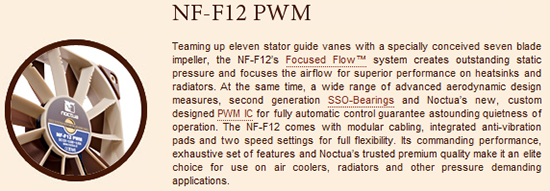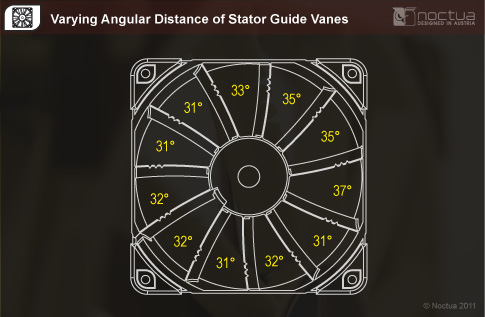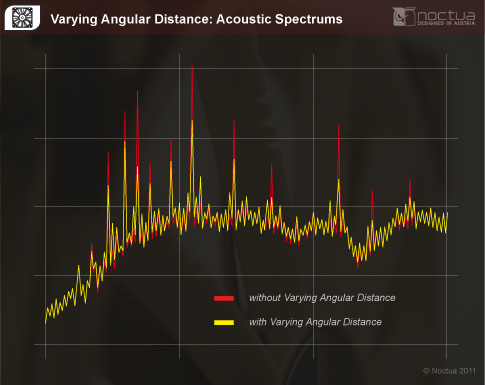Noctua Focus Flow 120mm NF-F12 PWM Fan Review
Focus Flow – A Technological Step Forward For Noctua

Today, we shall be explaining to you why these innovations on Noctua’s past technologies are important and why they made these changes.

Here is the heart of the Focus Flow technology, the VAD design with Stator Vanes. In the past, to help achieve an overall better sound profile, Noctua used “Vortex Control Notches” on the blades of their fans to help change the frequency of the sound coming from the fan’s airflow, to make it more tolerable by the human ear.
Unfortunately, this design caused a loss in static pressure, which is a much needed attribute for a fan that’s used on a Radiator or Heatsink.
This time around, Noctua instead chose to make the fan blades of Focus Flow fans have a varying angular distance from the stator vanes, which now hold the “vortex control notches.” What occurs from this design is still the desired change in sound profile but without the loss of static pressure, letting the fan still be considered a performance part while not lacking Noctua’s signature silence attribute.
The stator vanes on the housing of the fan would normally increase turbulence of the airflow, which would thus increase the static pressure of the fan. Unfortunately, with the increase in turbulence you also get an increase in noise from the fan, and usually it is of the undesirable nature. With this in mind, Noctua used the vortex control notches to change the sound profile of the fan, so while the sound pressure is still “loud” by comparison to their previous products, the fan itself should not sound as loud as it is, since much of the frequency spikes are reduced due to the vortex control notches, and the stator vanes themselves help keep the static pressure of the fan relatively high.
Now, some of you may be wondering, “Why did Noctua use this ‘varying angular distance’ stuff for the stator vanes?” The answer is relatively simple, and goes back to the frequency discussion. By having the stator vanes at varying angles from the blades themselves, you then create a wide frequency range of noise, instead of a single pitch of noise, making the sound profile of the fan itself more like the white noise of a normal room instead of the higher pitched “whoosh” of air moving through the fans and over the stator vanes.
While I do not have the ability myself to do the high resolution recording of the sound profile of this fan, I will be providing my subjective opinion later on. Noctua does give you a very (albeit poor) depiction of what this technology does on a frequency standpoint:

While Noctua does not depict the resolution nor the depth of this graph, it does hold some significance; what they are depicting here is the high pulse frequencies created by stator vanes on a fan, and what happens when you do and do not use the VAD technology.
The red spikes on this graph represent what happens with a fan that uses Noctua’s stator vanes but not VAD Technology, while the yellow spikes are Noctua’s stator vanes with VAD technology. The lower resolution spikes mean the frequency of the noise is lower each time that blade passes over the vane itself, thus giving the perception that the fan itself is quieter.
Coming up, we’ll give you a look into the SSO2 Bearing and NE-FD1 PWM IC, so that you can better understand these design implementations from Noctua.

Comments are closed.